The aurochs
is often remarked for its impressive horns, which were
larger than those of most domestic cattle. Contrary to some other claims,
the horns of the aurochs were – just like those of other wild cattle – more or
less uniform so there are clear objectives that breeding-back should focus on.
Curvature
Some
authors compare the curvature of the aurochs’ horns to a spiral, which they
call the “primigenius spiral” [1]. Because this is a useful term, I’ll continue
to use it when referring to their characteristic shape here, which consists of
a curve going outwards and upwards at the base, then curving downwards again,
forwards and inwards, and finally inwards and upwards at the tip.
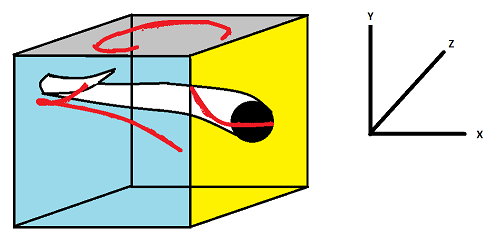 |
| Image by Miguel Omar Ruiz Hernandez showing the 3-dimensional shape of the aurochs horn |
The base
was the thickest part of the horns and the tip usually ended slim and pointy,
what surely was intensified by the keratinous horn sheath in life.
There are a
lot, possibly hundreds, of preserved bony aurochs horn cores found in- and
outside Europe. This amount of material tells us that the primigenius spiral
shape was always present [1], but there was variation in the way the horns
exactly showed that curve. Some individuals had more wide-ranging horns, such
as a skull displayed in Stuttgart, while others had very inwards-facing ones,
such as the bull from Prejlerup.
 |
| Pleistocene skull with wide-ranging horns found, Stuttgart (Photo: ©Markus Bühler) |
 |
| Life reconstruction of the Prejlerup bull, Denmark, with very inwards-curving horns. All rights reserved. |
One aurochs might have had comparably slim
horns while another one had very thick ones. Also the angle in which the horns
were attached to the skull varied. According to Cis van Vuure 2005, the angle varied
between 50° and 70° and also other authors found 60° to be the arithmetic mean.
However, I have seen photos of skulls which show an angle either larger (Vig)
than 70° so the total scope might be slightly larger.
_01.JPG/800px-Museo_arezzo,_bos_primigenius_da_montione_(AR)_01.JPG) |
| Bull skull from Italy with sharp angle between snout and horns |
 |
| Bull skull from Vig (Denmark) with more upright horns |
The
position of the horns relative to the skull changes the way how the horns look
in frontal view. The larger the angle to the snout is, the more < >
-shaped the horns appear (I don’t have word for that, some call it “lyre
shaped”, but a lyre looks more like the horns of Steppe cows to me). The lower
the angle is, the more the horns look like that of good Maronesa or Lidia
bulls. My aurochs horn model, made from DAS clay and painted with acrylics,
photographed from different angles, illustrates that very well.
For anyone
interested, the model measures 78 cm in length and has a circumference of 40 cm
at the base.
 |
| Reconstruction of a lost skull from Berlin. All rights reserved. |
Size
According
to Cis van Vuure, the smallest and largest horn diameters at the base are 7 and
18 cm, the smallest and largest length 40 and 107 cm. These measurements were
obtained from bony cores, so we have to consider the keratinous sheath, which
adds about 10-20 cm in length [1] and 8% (therefore a few centimetres) to the
circumference at the base [2]. A large Pleistocene skull that was found at
Mannheim, Germany, had horn cores with a length of 93 cm and a horn span (from
the outermost point of one horn to the other) of 123. Large skulls like these
are no exceptions, the probably largest known aurochs skull is exhibited at the
British Museum, London, and measures incredible 91,2 cm in profile. Surely this
must have been a huge bovine. Other Pleistocene samples from Italy, which was a
refuge for aurochs and other mammals of the interglacial fauna during the Würm
glacial, show aurochs of very large size as well. Some horns of the Chiana
Valley have a circumference of ~43 cm, the largest specimen are known from an
area near to Rome, which had a length from 69,2 to unbelievable 120 cm (still
without keratin) [2]. The horns of the Indian aurochs where about the same
size, but since the B. p. namadicus
was slightly smaller overall than B. p.
primigenius, they were proportionally larger. With the end of the ice age
the horns of the aurochs tended to be less huge and wide-ranging [2,3], but
were still impressive. This reduction of size is probably connected to the
disappearance of large feline predators, and the same happened to Bison as well
after Panthera leo atrox died out,
when you compare the horn dimensions of Bison
priscus with those of extant B. bison.
However, aurochs still had to deal with wolves in the Near and Middle east and
North Africa.
 |
| Ridiculously huge pleistocene horns, found in Germany. |
 |
| Very large skull on display at Lodon. Photo © Marie Griggs |
Sexual dimorphism
The horns
of the aurochs are said to display a clear sexual dimorphism [1,2,3]. Usually
the horns are described as being larger than those of the cows, which sounds plausible
(but read on). Of the skulls I had a look on (and I know really a lot of photos
of aurochs skulls), cows seem to have more wide-ranging, more upright and less
strongly curved horns than the bulls. A considerable size difference is not
really apparent for me, but I trust the experts. In domestic cattle, the bulls
usually have more forwards-pointing horns while those of the cows are longer
but thinner – how can that be? First of all, who knows how much keratin plays a
role here. Furthermore, it is not always easy to determine the sex only from
fragmentary skeletons, and there were probably exceptions regarding the horns
within one sex of the aurochs as well. The Vig specimen for example, which is
thought to be a male because of its large size and massive bones, has very
female horns (they appear female in being very upright by aurochs standards,
thin and do not curve inwards very strongly). What is strange is that in
domestic cattle of the same breed the horns of the bulls are usually straighter
and more outwards than in cows, you can see that in a number of breeds
(Sayaguesa or Heck, for example).
Horn sheaths
A number of
keratinous horn sheaths still exist; their either survived in turf or as
ornamented (drinking) horns which where owned by the European nobility. One of
the best-preserved and best-known aurochs horn sheaths is that of the last
aurochs bull which died in 1620, which is now kept at the armoury of Stockholm.
It shows the least discolouration because it is the youngest, and also is very
slim compared other horn sheaths of the middle ages or older bony cores, what
probably shows that the last aurochs at Jaktorow, Poland, had slightly
diminished horns due to their limited range and trophy hunting [2]. The same is
also known from elks but I have no reference for that at hand at the moment.
The Danish national museum also has an impressive collection of a number of
ornamented aurochs horn sheaths. Most of them are discoloured.
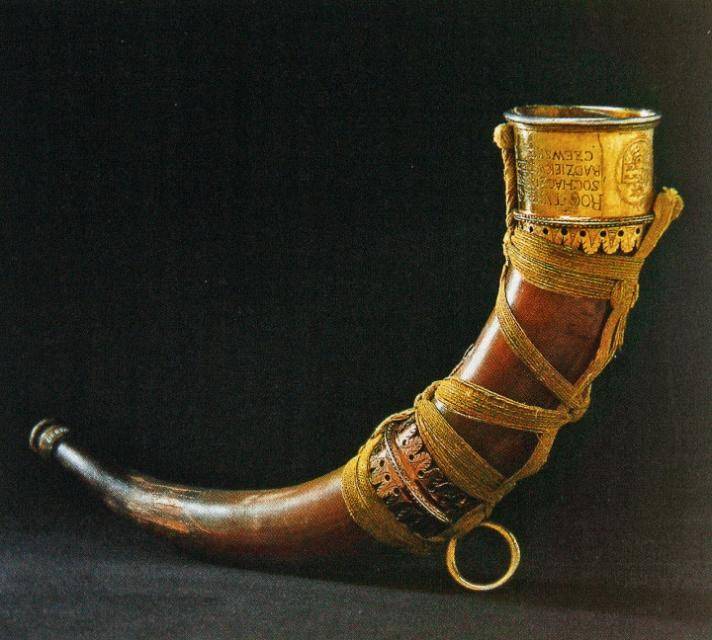 |
| Horn of the last living aurochs bull which died in 1620 at Jaktorow |
Another
horn which shows only slight discolouration and mightier dimensions than the
one from Jaktorow is displayed at Brussels. When looking at the photos of all
those beautiful sheaths you’ll see that the base is rather massive and the tip
is very slim (consider that most of the
ornamented horn tips have their horn tips cut off), more so than in the bony
cores. This tells you that the sheath adds pretty much to the length of the
complete horn. The photos of some horn sheaths give you the impression that the
horns have a rather two-dimensional crescent-shape, instead of the classic
three-dimensional horn shape of the aurochs. This might be just an optic effect
of the photo, or can be explained by the fact that both their tips and bases
are cut in order to attach the ornamentation.
 |
| Horn sheaths at Servaasbasiliek, Netherlands |
Compared to other wild bovines
The horn
curvature of the aurochs is said to be characteristic for the species, probably
because most domestic cattle lost it. But is it really an apomorphy, which is a
derived state which characterises the species or group you are looking at, or
is it a plesiomorphy, which means that it is inherited from its ancestors? The
easiest way to solve such a question is to look at close relatives of the
aurochs.
At first
glance, the horns of Bantengs and Gaurs do not resemble those of the aurochs;
they are very vertical and the only similarity seems to be the well-pronounced
inwards-curve. But taking a closer look, especially on moving pictures, shows
that they actually do have the primigenius spiral, just less strongly expressed.
The same is also true of the horns of many wisents. The photo below shows an
individual with particularly aurochs-like horns that I photographed at the
Hellabrunn Zoo at Munich. The males of the probably extinct Kouprey had horns
that resemble the aurochs closely, the most obvious difference being only
bristles at the tips and wrinkles at the base. But the biggest similarity in
terms of horns we can find in wild yaks – some individuals have horns that are
virtually indistinguishable from those of the aurochs.
 |
| Yak skull with horn curvature identical to that of the aurochs |
 |
| Wisent with aurochs-like horn curvature at Zoo Hellabrunn, Munich |
This tells
us that the horns of the aurochs are clearly not a defining character, an
apomorphy, of the species Bos primigenius.
The fact that closely related species display the same horn curvature implies
that their common ancestor, the ancestor of both Bos and Bison, must have
had the same horn curvature. This holy concept of parsimony in my opinion also
rules out Bos acutifrons as a possible aurochs ancestor because it had very long
and wide-ranging horns, unlike all other extant Bos members.
In modern cattle
As I wrote
above, most domestic cattle did not retain the horn characteristics of the
aurochs over the millennia of domestication. Therefore the horns distinguish
the wild type from the domestic type very well, and it’s important for
breeding-back to achieve “good” aurochs-like horns – not only for our
satisfaction, but also because horns play an important role in the life of wild
cattle.
Is there
any breed that has horns identical or nearly identical with those of the
aurochs? To answer that question properly, horn size and horn shape, consisting
of curvature and orientation relative to the skull, should be viewed
separately.
Horn size
Domestication
tended to reduce the horn size of cattle. Only few cattle breeds, which mostly were
artificially selected for horn size like Texas Longhorn, Barrosa/Cachena,
Watussi and some Heck cattle have horns the size of what we see in large-horned
aurochs. Steppe-type cattle like Maremmana, Boskarin and Hungarian gray also
have horns matching the size of those of the aurochs, especially in length.
Some Maremmana primitivo bulls display very thick horns. Highlands have the
right horn length, but their horns are mostly – with some exceptions – rather
thin. The horns of Maronesa also fit into the aurochs horn size range, but a
bit more on the smaller than on the larger end I would say. Most Maronesa cows
also have considerably thinner horns than in the aurochs.
 |
| Maremmana bull |
 |
| Cachena cow |
Curvature
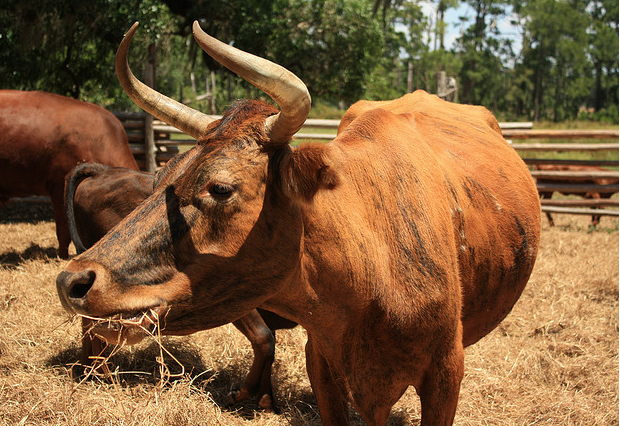 |
| Dairy cow in Brazil with perfectly aurochs-like horn curvature |
Surprisingly,
a number of derived dairy and milk breeds occasionally show horns with a
virtually perfect aurochs curvature, which was also recognized by Cis van Vuure
[1]. With some exceptions, like the Eringer breed, these horn shapes are never
fixed and found only in single individuals. Of the primitive breeds, many
Maronesa bulls and also some cows show horns with a curvature almost identical
to that of many aurochs skulls, although the orientation relative to the skull
is smaller in Maronesa on average. In many cows however, the horn tips face too
much outwards, in some individuals to such an extent that they look
corkscrew-like. The same is true for the related breed Barrosa, where the horns
of cows are quite vertical but some bulls of this breed have a very
aurochs-like curvature.
 |
| Maronesa bull with perfectly aurochs-like horns, albeit oriented slightly too low |
 |
| Barrosa bull with aurochs-like horns |
The Spanish fighting cattle have horns of variable
curvature, and some of them display a very good resemblance to those of the
aurochs. Many other Iberian breeds have horns which curve in an aurochs-like
manner but show some more or less clear differences. For example,
outwards-curving horn tips in cows are quite common, but that does not rule out
that some single individuals of breeds like Sayaguesa show decently
inwards-curving horns.
As
portrayed in a previous post, single Highland cattle individuals show a very
aurochs-like horn curvature. The range of horn curvatures we see in Heck cattle
are extremely variable too, and in improved lineages the Wörth lineage or
Taurus cattle we see individuals with horn curvatures resembling the aurochs
very closely as well, although in the former the horns tend to face too much
outwards and the latter needs more inwards-curving horn tips as well. Even some
Watussi cattle display horn shapes reminiscent of the aurochs, although often
curving not strongly inwards enough and being to upright.
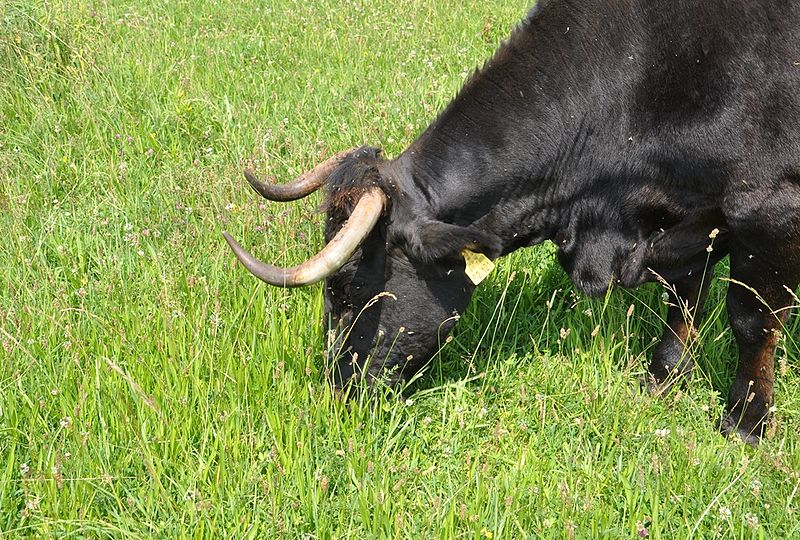 |
| Sayaguesa cow with horns facing inwards |
Taking both
horn size and curvature, the number of breeds which fit the bill gets
considerably smaller. Actually there is no breed in which the horns always fit
the aurochs both in size and curvature. Some primitive Barrosa bulls come very
close in absolute dimensions and curvature, the same goes for primitive
Maronesa bulls albeit the horns are oriented lower in this breed than in the
aurochs. The horns of most of the cows however do not resemble the aurochs that
much; in female Barrosa they tend to be more upwards and lyre-shaped, while in
Maronesa the often show a thinner, corkscrew-like shape and are considerably
lower than in aurochs cows.
 |
| Wörth Heck cow "Erni" with slightly oversized horns (in relation to the animal) which are perfect in absolute size and curvature |
The
overwhelming majority of Heck cattle of this world have horns far from being
identical with those of the aurochs. Yet there are a few individuals of
improved lineages that have horns that resemble their wild type very closely.
My favourite example is the cow Erni of the Wörth breeding lineage. Surely her
horns are slightly too large in relation to the animal, but the absolute
dimensions are absolutely authentic. I saw that cow in real and her horns give
a lively impression of what an impressive animal the aurochs was. Apart from
that, the curvature of the horns are absolutely correct. The Wörth lineage has
some more examples of correctly aurochs-like horns, but they are not stabilized
even in this lineage.
Do you find this topic interesting? Check out my book on Amazon!
Literature
[1] van Vuure, Cis: Retracing the Aurochs - History, Morphology and Ecology of an extinct wild Ox. 2005.
[3] Frisch, Walter: Der Auerochs – das europäische Rind. 2010.
[3]
Hans-Peter Uerpmann: Der Rückzucht-Auerochse und sein ausgestorbenes Vorbild. Neandertal Museum 1999.

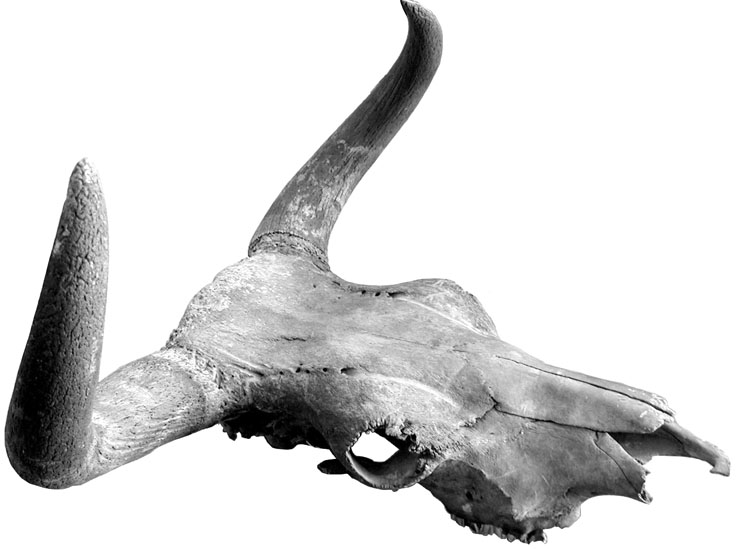

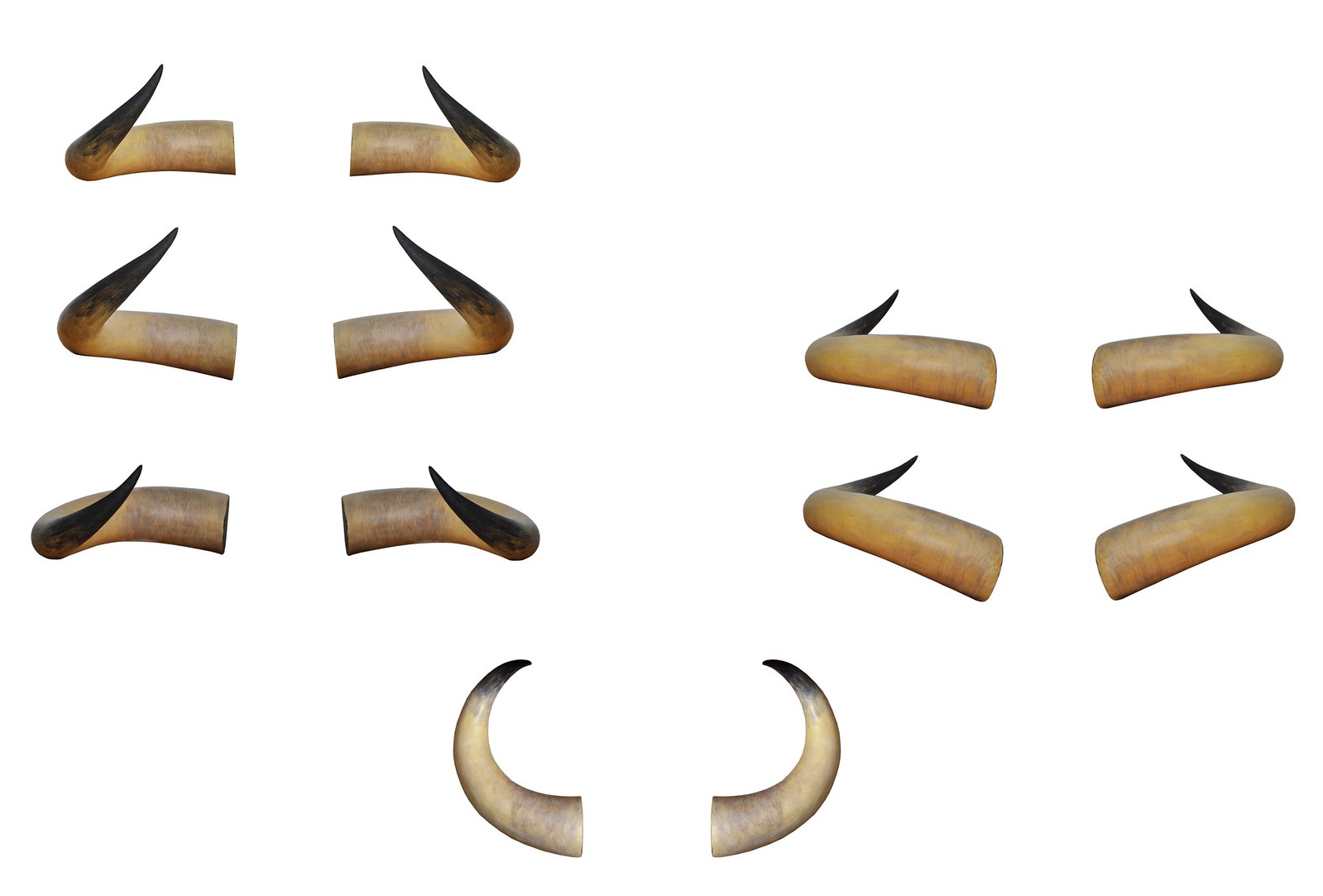

insightful
ReplyDeleteI know you are aware of the skeleton in the Cambridge University collection. Do you know of the horns in the Sedgwick Museum of Earth Sciences on the Downing Site? If you would like photos perhaps you can give me an address. I don't know how to download them here.
ReplyDeleteI didn't know them before, I'd very much like to see photos! Thanks for the offer very nice. You can send them to daniel.foidl( )itmed.at (the space, of course, is for "@"). Thanks again.
DeleteCan I ask you a question (maybe by email) about one of the pictures in this article?
ReplyDeleteExtinct cattle horn found by fisherman in Severn estuary:
ReplyDeletehttps://www.dailymail.co.uk/sciencetech/article-8379937/Giant-27-inch-horn-belonging-auroch-River-Severn-estuary.html
https://www.thesun.co.uk/news/12028423/boss-rare-6000-year-old-horn-early-sold-it-on-ebay/
https://www.dailymail.co.uk/video/sciencetech/video-2183660/Video-6-000-year-old-extinct-Auroch-horn-discovered-Wales.html
https://www.bbc.com/news/uk-england-gloucestershire-52833791
https://www.walesonline.co.uk/news/wales-news/horn-extinct-creature-died-around-18329016
THE HORNS OF THE AUROCHS - BREEDS OF CATTLE IN NORTHERN PORTUGAL:
ReplyDeletehttps://atahca.pt/atahca_gestor/kcfinder/upload/files/os-cornos-do-auroque.pdf
https://bibliografia.bnportugal.gov.pt/bnp/bnp.exe/registo?2025961
https://bibliografia.bnportugal.gov.pt/bnp/bnp.exe/registo?2025961&cl=pt
https://bibliografia.bnportugal.gov.pt/bnp/bnp.exe/registo?2025961&cl=en
https://bibliografia.bnportugal.gov.pt/bnp/bnp.exe/registo?2025961&cl=fr
http://www.drapn.min-agricultura.pt/drapn/conteudos/cen_documentos/outros/OsCornosdoAuroque.pdf
http://www.pecuaria.pt/conteudo_mobile.php?idart=3208
Deletehttp://leader2020.minhaterra.pt/livro-34os-cornos-do-arouque-racas-de-bovinos-no-norte-de-portugal34.T919.php
http://www.amiba.pt/2007%20OsCornosdoAuroqueRacaBarrosa.pdf
https://twitter.com/auerrind/status/1504022702222450688
ReplyDeleteHi, here there are videos of caught wild yaks in china, you may be interested in the horns https://youtu.be/411M9oDOews
ReplyDeleteI have inherited the largest aurochs horn extant in a private collection. It is 124cms long. It is mounted on an ancient bronze base and has perfect curvature. On the whole it is probably the best example anywhere. I would consider selling it. if you a
ReplyDeletere interested send me a mail. Danielvanackere888@gmail.com